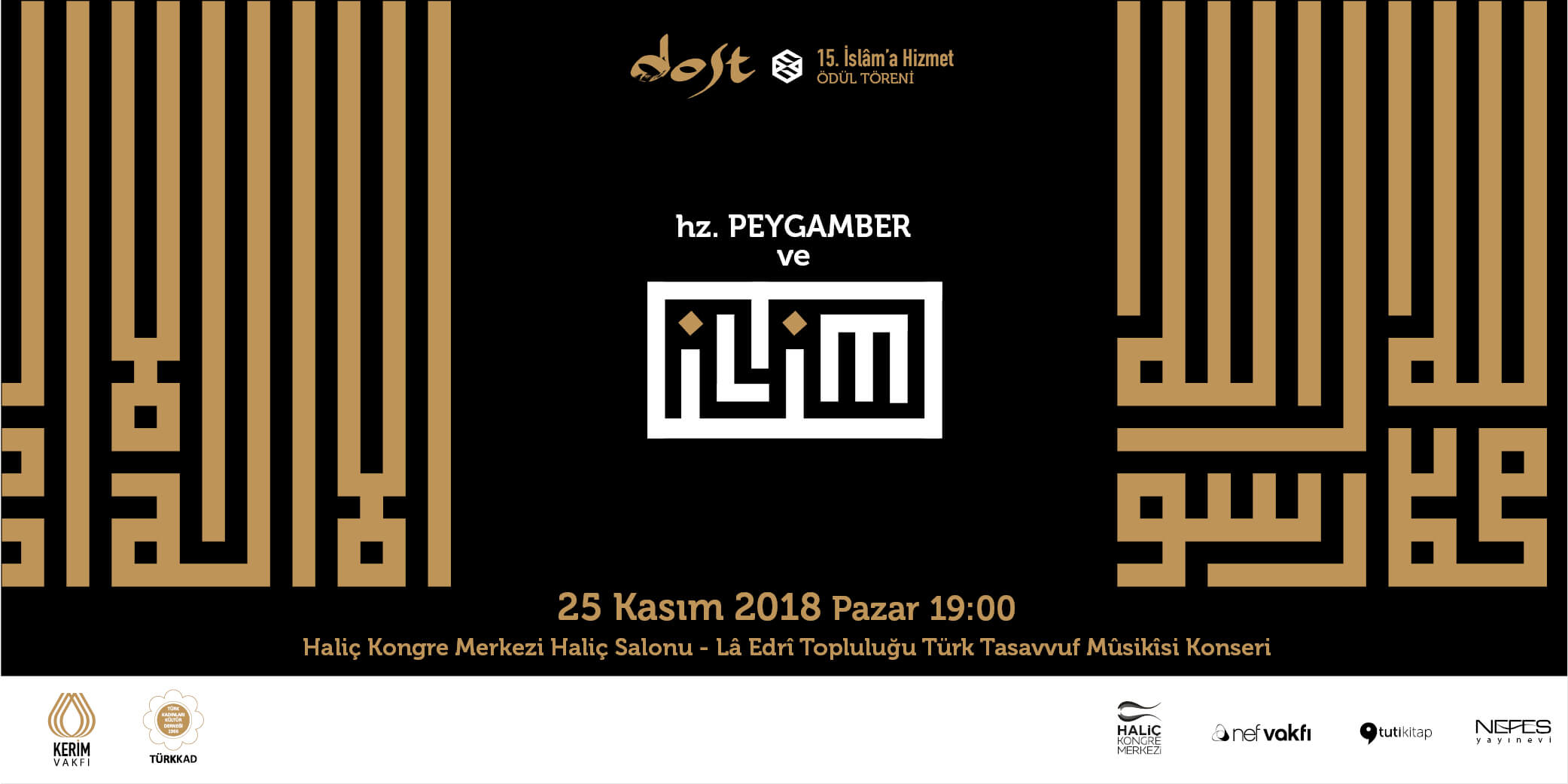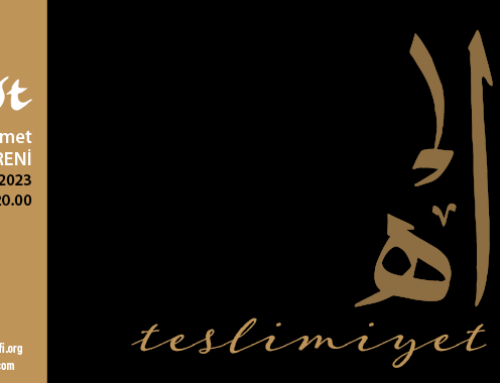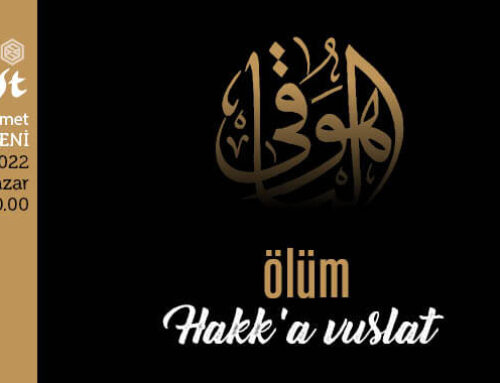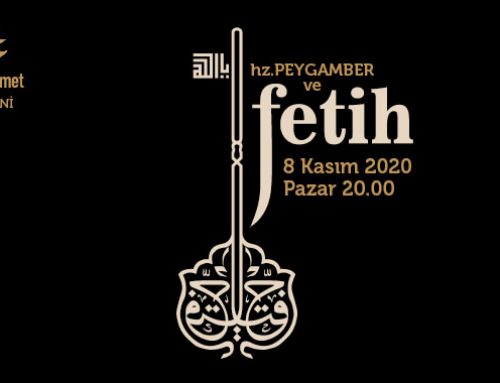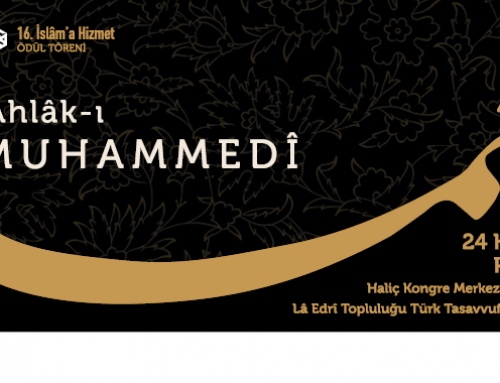Project Description
“The Prophet and Science” Title 15. DOST Awards for Service to Islam Presentation Ceremony
15th DOST Awards for Service to Islam Presentation Ceremony – LIVE
Lâ Edrî Ensemble Turkish Sufi Music Concert – LIVE STREAM
The 15th DOST Service to Islam Awards presentation ceremony titled “Prophet Muhammad and Science” will be held on Sunday, November 25th in Istanbul.
The Prophet, who was sent as a mercy to the worlds. An annual event to commemorate the anniversary of the birth of Prophet Muhammad (PBUH) and his love that unites everyone under the banner of Tawhid (monotheism).
“DOST” Service to Islam Awards”
On Sunday, November 25, the awards will be presented at a ceremony to be held at the Haliç Congress Center.
“Hz. The Prophet and Knowledge” will be presented at a night to be organized under the title
15th “DOST” Awards for Service to Islam
Ahmed Avni Konukfrom Turkey and Seyyed Muhammad Naqib al-Attasfrom abroad.
AWARD CEREMONY DATE: Sunday, November 25, 2018, Time: 19:00
AWARD CEREMONY LOCATION: Golden Horn Congress Center, Golden Horn Hall
Sponsors of the Night: Haliç Congress Center, Nef Foundation, Nefes Publishing and Tuti Kitap
Participation is free and open to all.
***The live broadcast of the 15th DOST – Service to Islam Awards Presentation Night is organized by Nefes Publishing House Inc.
AHMED AVNI GUEST (1868 – 19.03.1938)
Sufi, composer and poet Ahmed Avni Konuk was born in Istanbul in 1868. His father was Musa Kazım Bey and his mother was Fatma Zehra Hanım.
After graduating from primary school, Ahmed Avni Bey entered Galata Rüşdiyesi, completed his hıfz and became a hafız (hafiz), attended mosque classes and received an icazet in Islamic sciences. When he was nine or ten years old, young Ahmed Avni lost first his father and then his mother within a few months of each other, and it was not possible for him to continue his education at the high school. He entered Dârüşşafaka with an exam and graduated in 1890.
In 1890, before graduating from school, he was appointed as a postal clerk at the Galata Post Office. During his civil service, he entered the Mekteb-i Hukūk-ı Şâhâne and graduated at the top of his class.
Fluent in Arabic, Persian and French, Mr. Ahmed Avni Bey served as pen manager, deputy general manager and legal advisor to the general manager at the Postal Ministry, respectively. He prepared the postal law. He received many commendations for his efforts and service throughout his civil service and was awarded with the white-striped Independence Medal.
Ahmed Avni Bey is a great Sufi. The three great Sufis who stand out in his life are Zekâi Dede Efendi, Mesnevîhân Mehmed Esad Dede and Ahmed Amiş Efendi, one of the greats of the Halvetî-Melâmî path.
Ahmed Avni Bey’s encounter with the music master Zekâi Dede Efendi took place during music lessons at the Dârüşşafaka School. Zekai Dede was the school’s first music teacher and taught for 21 years without remuneration until his death.
Ahmed Avni Konuk is the compiler of Hânende, the largest collection of lyrics we have. This work contains the lyrics of 2706 works from 95 makams.
Like his master Zekai Dede, Konuk paid great attention to the harmony between usûl, makam and lyrics.
His known works number 41. The highest level of composer in our music is the composer of liturgy.
Konuk composed 3 Mevlevî Âyîn in the modes of Bûselikaşîrân, Dilkeşîde and Rûy-i ırak. He also composed 1 Kâr-ı Nâtık, 3 Kâr, 8 Beste, 5 Ağır and 5 Yürük Semâî and 16 songs. He composed two maqāms, Dilkeşîde and Bend-i hisâr. He composed a classical fasıl in Dilkeşîde maqâm and Râhatu’l-Ervâh maqâm.
His “Fihrist-i Makāmāt” (Fihrist-i Makāmāt), a Kār-ı Nātık with 119 makāms, is a very important work that shows the largest number of makāms today.
He also has great talent in poetry. He also wrote the lyrics of all the oral works he composed. He translated in verse the Persian and Arabic poems in the Sufi works he commented on. He used the pseudonym Avnî in his poems.
In response to Tevfik Fikret’s famous “Târîh-i Kadîm’e Zeyli”, which was full of attacks on religion, he wrote a 164 couplet poem, repeating Mehmet Akif’s attitude to protect religion and faith from the attacks in this poem, and answering his poem part by part in a style appropriate to Fikret’s style.
It has trained masters such as Ahmed Avni Konuk, Hacı Emin Dede, Halil Can, Kemal Batanay, Saadettin Heper, Emin Kılıç Kale, who have provided great services in transferring our classical music to today. Hacı Emin Dede said of his master, “Ahmet Avni Bey is Itrî-i zaman,” meaning “the Itri of time.”
In 1904, Ahmet Avni Bey became a member of the Mawlawiyya order by initiating himself into Mesnevîhan Selânikli Mehmed Esad Dede. He was one of the three most prominent students, along with Tahir al-Mawlawi and Abdülhay (Öztoprak), the last sheikh of the Beşiktaş Yahyâ Efendi lodge. He learned Persian from his mentor. He attended the Mesnevi and Fusus lessons and received his license and was deemed worthy of the title of “mesnevîhânlık”.
Ahmed Avni Konuk’s works, the majority of which are Sufi in nature, are more than thirty in number. The main ones of these works, some of which have been published, are as follows:
Mesnevi Translation and Commentary is the most comprehensive commentary in Turkish.
Muhyiddin Ibn ‘Arabî’s translation and commentary of Fusûsü’l-hikem is his second greatest work. It consists of twenty-eight oversized notebooks. He also made use of modern sciences in this commentary.
Apart from these two giant works, the translation and commentary of Muhyiddin Ibn ‘Arabî’s Et-Tadbîrâtu’l-Ilâhîye, and the translation and commentary of Hz. Translation of Mevlânâ’s Fîhi Mâfih, translation of Sipehsâlar.
Ahmed Avni Bey is referred to as “Darülfünun” or “the house of sciences”. Very difficult mystical books like the Fusus. It is obvious that a great deal of intellectual and Sufi competence is required to comment on these texts. As a matter of fact, he used about 20 Hind commentaries in his commentary of the Masnavi. Not only classical sources As can be seen in the introduction to the commentary on the Masnavi, it is clear that orientalists such as Nicholson and Spinoza It also dominates the work of philosophers such as These are the facts that show that he was a great scholar who also mastered the science of his time. are examples of this.
His most important characteristic in the field of Sufism is that he is the most prominent Sufi mystic between Mawlana and Ibn Ibn Kamal, who are considered by some to be very different from each other.Arabi’s unification of his gaze, his vision. He made these two oceans talk to each other and comment on each other.
He voluntarily retired in 1933. For a while, he taught at the Post and Telegraph High School and the High School of Engineering, which would later become ITU.
In his last days, the guest married Emine Hadiye Hanım.
He died on March 19, 1938 at the age of seventy. His body was buried in Merkezefendi Cemetery, in the treasury on the qibla side of the mosque.
Ahmed Avni Bey is a versatile and prolific writer. He did things that had not been attempted before him, and he took things that had been done even further.
Sayyid Muhammad Naqib al-Attas was born in 1931 in Bogor, Indonesia, the middle of three brothers. His lineage is from the Prophet. Al-Attas’ paternal grandfather, Sayyid Abdullah bin Muhsin bin Muhammad al-Attas, was a saint whose influence was felt from Indonesia to Arabia, and his mother was a member of the Indonesian Sundanese royal family. Al-Attas’ grandmother, Mrs. Rukiye, belonged to an aristocratic Turkish family.
At the age of 5, his family sent him to Malaysia (Cohor) for his education. He stayed there with his grandmother Mrs. Rukiye, his uncle and aunt. During the Japanese occupation of Malaysia, he returned to Indonesia (Java) to continue his education and studied Arabic at an Al-Urwatu’l-Wuthqa madrasa. After the Second World War, in 1946, he continued his education in Malaysia, first at Bukit Zahrah School and then at an English school. During this time he lived with both the sultan’s cousin and Cohor’s 6th cousin. His uncle (Ungku Abdul Aziz), who became Prime Minister, had an extensive library of Malay manuscripts on Malay literature and history. Sayyid Muhammad Naqib spent much of his youth reading these texts on history, literature and religion, as well as Western classics in English that were in the collections of other family members. Through this cultural atmosphere and reading, al-Attas developed a superior style and an impeccable vocabulary that shaped his own Malay and writing. His relationship with these manuscripts left a lasting and important mark on his life. Today, his personal collection includes some very important Arabic and Malay manuscripts that are not included in any catalog, including Van Ronkel’s catalog.
When Ungku Abdul Aziz retired, his other uncle, Cohor VII. The Prime Minister lives with nationalist Dato’ Onn bin Dato’ Jaafar, also the founder of the UMNO (United Malay National Organization) political party. Recognizing Al-Attas’ artistic talent, his uncle asked him to draw UMNO’s official flag, saying that it should have elements of power, Malay kingship and the Islamic religion.
After completing his high school education, he enrolled in the Malay Military Academy. He was then selected by the British High Commissioner to Malaya, General Sir Gerald Templer, for military training in England, first at Eaton Hall (Chester, Wales) and then at the Royal Military Academy (Sanhurst). Here he develops a deep understanding of the influential section of British society. Gains important friendships. One of them was Sharif Zayd bin Shakir, a cousin, colleague and friend of King Hussein of Jordan.
His attraction to Sufism began with an encounter with the works of the Iranian Islamic scholar Mullah Jami, which he found in the library of the Sanhurst Academy. After graduating, Al-Attas received the king’s commission to become an officer in the Royal Malay Regiment and took an active part in the work against terrorists in the Malay jungles. However, due to his love for learning and his academic activities, he voluntarily withdrew from military service to continue his studies at the University of Malaya, Singapore (1957-59). There is no doubt, however, that his military training – especially the Islamic elements of order, discipline and loyalty – influenced his views and methods as an Islamic scholar and administrator.
He wrote two books while still a student at the University of Malaya. One of them is his classic work “Some Aspects of Sufism as Understood and Practiced Among the Malays”, later published by the Malaysian Institute of Sociological Research in 1963.
For this work, he traveled all over the country, meeting with all the important Sufi leaders, learning about their ways and observing their practices. Due to the interest in the work, the Canadian government awarded Al-Attas a Canada Council Fellowship in 1959, an unprecedented three years in a row.
Al-Attas continued his studies at the Institute of Islamic Studies at McGill University in Montreal, Canada. Here he met notable scholars such as Sir Hamilton Gibb, Fazlur Rahman, Toshihiko Izutsu and Seyed Hussein Nasr. He received his master’s degree (from the Institute of Islamic Studies of McGill University) in 1962 with his thesis titled “Raniri and the Bodudiyya Movement in Aceh in the 17th Century”. A year later, with the encouragement of distinguished academics such as professors from Cambridge and the British Academy and the president of the Royal Asiatic Society, he transferred his doctoral studies to the School of Oriental and African Studies at the University of London. There he worked with Professor Arbery and Martin Lings.
Even during his years of study at McGill and in London, Al-Attas actively worked to spread the true message of Islam against its misrepresentations.
When he returned from the University of London in 1965 as a Doctor of Philosophy, one of the few Malaysians to hold this title, he was first appointed Head of Literature, Department of Malay Studies, University of Malaya. Between 1968-70, he served as the head of the department of the Faculty of Art at the same university. Between these years, he introduced a number of reforms in the academic structure of the faculty. It was also at his initiative that the language of instruction at the faculty was changed to Malay, despite objections from other professors.
Al Attas was one of the founders of the National University of Malaysia (1970), which advocated for the language of instruction to be Malay rather than English. It was also thanks to him that the philosophical foundation of the university was established and the Faculties of Science and Islamic Studies were founded. It proposes new methods for the study of Malay language, literature and culture. Among them is a genuine study of the role and influence of Islam and its real relationship with other regional and national languages. In 1973, to realize his plans, he founded the Institute of Malay Language, Literature and Culture at the new university.
Sayyid Muhammad Naqib al-Attas has expertise in many academic fields such as theology, philosophy and metaphysics, history and literature. He has written extensively on various aspects of Islamic thought and civilization, especially on Sufism, cosmology, metaphysics, philosophy, and Malay language and literature.
In 1975, in recognition of his outstanding contributions to the field of comparative philosophy, he was awarded membership of the Imperial Iranian Academy of Philosophy, which included such esteemed scholars as Professor Henri Corbin, Seyed Hossein Nasr, Toshihiko Izutsu, and others.
In 1979, the President of Pakistan, General Muhammad Zia ul-Haq, presented him with the Iqbal Centenary Commemorative Medal.
In 1987, he founded the International Institute of Islamic Thought Civilization (ISTAC) with the aim of reviving an Islamic tradition of thought and science and served as its president for many years.
Al-Attas is also an accomplished calligrapher whose work was exhibited at the Tropen Museum in Amsterdam in 1954.
The ISTAC (INTERNATIONAL INSTITUTE FOR ISLAMIC CIVILIZATION AND THE MALAYSIAN WORLD (ISTAC)) building, the unique al-Ghazali lecture hall and the mosque in Kuala Lumpur, Malaysia, built in a traditional and cosmopolitan character and in an Islamic style, has its own plan, design, furniture and interior decoration, even landscaping. Many local and foreign scholars and visitors have expressed how successfully al-Attas reflected the deep and meaningful atmosphere of ISTAC. Professor Gulzar Haider, a renowned Canadian architect, said of him, “al-Attas can think in lines and shapes as effectively as he speaks in words and sentences. What I really feel is as if the building has prepared itself by bending down, ready to receive knowledge along with ‘Divine Beauty and Majesty’.” Seyyed Hussein Nasr of George Washington University, after his visit to ISTAC (in 1993), wrote to Aga Khan on his return to the United States that he found “the institute of exceptional beauty, certainly the most successful building in Islamic architecture in recent years”.
He is the only academic in Malaysia to have been awarded the honor of holding academic chair in various disciplines.
In his list of “Who’s Who in the World”, Marquis included Sayyid Naqib among those who have achieved extraordinary success in their fields of specialization.
In 1976, he was the chief advisor to the London Islamic World Festival and the chairman of the committee of the First Islamic Education Conference in Mecca. He chaired the UNESCO Meeting of Experts on the History of Islam in Syria.
King Hussein of Jordan made him a member of the Royal Jordanian Academy in 1994. This was followed by an Honorary Doctorate of Arts from the University of Khartoum, Sudan in 1995.
In 2000, he was awarded the IRCICA (Islamic Research Center for History, Art and Culture) prize for his excellent contributions in the field of Islamic civilization.
In 2001, he was awarded special prizes by the Russian Academy of Sciences and the Iranian Government.
He has given over 500 lectures in Europe, America, Japan, Far East and Muslim Countries.
He was the first in the modern Muslim world to systematically and philosophically define, conceptualize and elaborate the content of Muslim education, the idea and method of the Islamization of contemporary knowledge, the nature and establishment of the Islamic University, and the formulation and systematization of Islamic metaphysics and philosophy of science.
For him, given all the problems caused by modern secular Western civilization, it is clear that what is needed now is not a new version of the same Western pattern. On the contrary, it is necessary to fundamentally rebuild a completely different civilization rooted in true religious ideas and ideals. Al-Attas’s basic ideas and methods are a creative synthesis of what are recognized as the world’s greatest minds.
For the first time, El-Attas put forward the original theory on the Islamization of the Malay-Indonesian Archipelago, thus initiating a general awareness for the reinterpretation of Islamic history in South Asia.
Al-Attas is a true reformer of modern Islamic thought and especially higher education. Al-Attas’s constant struggle with the higher education establishment in his multi-religious but majority Muslim country, which was also undergoing a socio-economic transformation, enabled him to develop a keen understanding of the root causes and real solutions to the complex problems that seemingly plague modern Muslims.
Although al-Attas’s ideas have caused a reaction, they have also led to important developments in modern Islamic thought and practice.
Known mostly for his theses on the “Islamization of Knowledge”, al-Attas has published more than twenty books and numerous articles in the fields of philosophy, religion and education in Islamic culture. Some of his works in English and Malay have been translated into Arabic, Persian, Turkish, French, German, Russian and Japanese.
According to the Royal Islamic Center for Strategic Studies Report in 2010, he is one of the “500 most influential Muslims in the world”.
Fazlur Rahman, a famous Pakistani academic thinker, described Al-Attas as “a genius”.
In 1961, he married Latifah el-Attas in Washington and had 4 children from this marriage.
He is now 87 years old and continues to live and work in Malaysia.
Despite his advanced age, he continues to pass on his vast knowledge to younger generations through lectures and conferences at universities.
